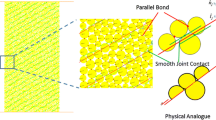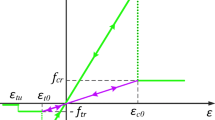Abstract
Triaxial compression tests were performed to determine the strength and deformability of small-scale rock mass models with multiple joint sets and frequencies under confining stresses up to 12 MPa. The cubical sandstone specimens (80 × 80 × 80 mm3) with joint sets simulated by saw-cut surfaces were compressed to failure using a true triaxial load frame. The joint frequencies ranged from 26 to 76 joints per meter. The results indicate that the Hoek–Brown criterion with two material parameters (m and s) can describe rock mass strengths as well as the three parameter criteria of Sheorey, Yudhbir and Ramamurthy-Arora. The parameter s notably decreases with increasing joint frequency, while parameter m is less sensitive to joint frequency. The confining stresses tend to enhance the effects of joint frequencies on rock mass compressive strengths. The deformation moduli in the direction normal to the joints tend to be lower than those parallel to the joints. They decrease with increasing joint frequency. Goodman’s equation was modified here to allow calculation of the deformation moduli of the rock mass along the three principal directions. The modified equation can sufficiently describe the deformation moduli normal and parallel to the joints for one-joint set and three-joint set specimens under all confining stresses.














Similar content being viewed by others
References
Bieniawski ZT (1974) Estimating the strength of rock materials. J S Afr Inst Min Metall 74:312–320
Boonsener M, Sonpiron K (1997) Correlation of tertialy rocks in northeast, Thailand. International Conference on Stratigraphy and Tectonic Evolution of Southeast Asia and the South Pacific, Bangkok, Thailand, pp 656-661
Cai M, Kaiser PK, Uno H, Tasaka Y, Minami M (2004) Estimation of rock mass deformation modulus and strength of jointed hard rock masses using the GSI system. Int J Rock Mech Min Sci 41(1):3–19
Colak K, Unlu T (2004) Effect of transverse anisotropy on the Hoek-Brown strength parameter ‘mi’ for intact rocks. Int J Rock Mech Min Sci 41(6):1045–1052
Ebadi M, Nasab SK, Jalalifar H (2011) Estimating the deformation modulus of jointed rock mass under multilateral loading condition using analytical methods. J Min Environ 2(2):146–156
Edelbro C (2004) Evaluation of rock mass strength criteria. Dissertation, Lulea University of Technology
Goodman RE (1970) The deformability of joints, determination of the in situ modulus of deformation of rock. ASTM STP 447, American Society for Testing and Materials, pp 174-196
Goshtasbi K, Ahmadi M, Seyedi J (2006) Anisotropic strength behavior of slates in the Sirjan-Sanandaj zone. J S Afr Inst Min Metall 106:71–76
Halakatevakis N, Sofianos AI (2010) Strength of a blocky rock mass based on an extended plane of weakness theory. Int J Rock Mech Min Sci 47:568–582
Hoek E (1994) Strength of rock and rock masses. ISRM News J 2:4–16
Hoek E, Brown ET (1980) Empirical strength criterion for rock masses. J Geotech Eng Div ASCE 160(GT9):1013–1035
Hoek E, Brown ET (1998) Practical estimates of rock mass strength. Int J Rock Mech Min Sci 34:1165–1186
Hoek E, Kaiser PK, Bawden WF (1995) Support of underground excavations in hard rock. Balkema, Rotterdam
Hoek E, Carranza-Torres C, Corkum B (2002) Hoek-Brown failure criterion-2002 edition. Proceedings of the fifth North American rock mechanics symposium. Canada, Toronto, pp 267–273
Jaeger JC, Cook NGW, Zimmerman RW (2007) Fundamentals of rock mechanics, 4th edn. Blackwell, Australia
Kamonphet T (2012) Effect of cyclic loading peak shear strength of rock joints. Dissertation, Suranaree University of Technology
Komenthammasopon S (2014) Effects of stress path on rock strength under true triaxial condition. Dissertation, Suranaree University of Technology
Kulatilake PHS, Park J, Malama B (2006) A new rock mass failure criterion for biaxial loading conditions. Geotech Geol Eng 24:871–888
Nasseri MHB, Rao KS, Ramamurthy T (2003) Anisotropic strength and deformational behavior of Himalayan schists. Int J Rock Mech Min Sci 40(1):3–23
Rafiai H (2011) New empirical polyaxial criterion for rock strength. Int J Rock Mech Min Sci 48(6):922–931
Ramamurthy T (2001) Shear strength response of some geological materials in triaxial compression. Int J Rock Mech Min Sci 38(5):683–697
Ramamurthy T, Arora VK (1994) Strength predictions for jointed rocks in confined and unconfined states. Int J Rock Mech Min Sci 31(1):9–22
Saroglou H, Tsiambaos G (2008) A modified Hoek-Brown failure criterion for anisotropic intact rock. Int J Rock Mech Min Sci 45(2):223–234
Sheorey PR (1997) Empirical rock failure criterion. A.A.Balkema, Rotterdam
Sheorey PR, Biswas AK, Choubey VD (1989) An empirical failure criterion for rocks and joint rock masses. Eng Geol 26(2):141–159
Singh M, Singh B (2012) Modified Mohr-Coulomb criterion for non-linear triaxial and polyaxial strength of jointed rocks. Int J Rock Mech Min Sci 51:43–52
Sonmez H, Ulusay R (1999) Modifications to the geological strength index (GSI) and their applicability to stability of slopes. Int J Rock Mech Min Sci 36:743–760
Sridevi J, Sitharam TG (2000) Analysis of strength and moduli of jointed rocks. Geotech Geol Eng 18:3–21
Tiwari R, Rao KS (2006) Deformability characteristics of a rock mass under true-triaxial stress compression. Geotech Geol Eng 24:1039–1063
Wendai L (2000) Regression analysis, linear regression and profit regression, In 13 chapters; SPSS for Windows: statistical analysis. Publishing House of Electronics Industry, Beijing
Yang ZY, Chen JM, Huang TH (1998) Effect of joint sets on the strength and deformation of rock mass models. Int J Rock Mech Min Sci 35(1):75–84
Yoshinaka R, Yamabe T (1986) Joint stiffness and the deformation behaviour of discontinuous rock. Int J Rock Mech Min Sci 23(1):19–28
Yudhbir Y, Lemanza W, Prinzl F (1983) An empirical failure criterion for rock masses. Proc. Int. Congress Society of Rock Mechanics, Melbourne, pp 1–8
Acknowledgments
This study was funded by the Suranaree University of Technology and by the Higher Education Promotion and National Research University of Thailand. Permission to publish this paper is gratefully acknowledged.
Author information
Authors and Affiliations
Corresponding author
Rights and permissions
About this article
Cite this article
Thaweeboon, S., Dasri, R., Sartkaew, S. et al. Strength and deformability of small-scale rock mass models under large confinements. Bull Eng Geol Environ 76, 1129–1141 (2017). https://doi.org/10.1007/s10064-016-0871-9
Received:
Accepted:
Published:
Issue Date:
DOI: https://doi.org/10.1007/s10064-016-0871-9




